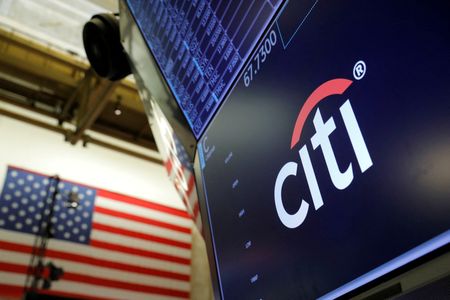By Sinéad Carew and Iain Withers
NEW YORK/LONDON (Reuters) -U.S. equities were slightly lower on Friday, a day after the S&P 500 and the Nasdaq scored record closes, as investors looked ahead to corporate earnings and monitored the latest U.S. tariff threats as they digested economic data, while the dollar weakened and U.S. Treasury yields fell.
U.S. consumer sentiment improved in July and inflation expectations declined, but households still saw substantial risk of price pressures increasing in the future, the University of Michigan’s Surveys of Consumers released on Friday showed.
Another report showed U.S. single-family homebuilding dropped to an 11-month low in June as high mortgage rates and economic uncertainty hampered home purchases, suggesting residential investment contracted again in the second quarter.
On Thursday, news of stronger-than-expected U.S. retail sales and jobless claims data suggested modest improvements in economic activity, helping to push equities higher.
On Friday, the mood dimmed after the Financial Times reported that U.S. President Donald Trump is pushing for a minimum tariff of 15% to 20% in any deal with the European Union, was unmoved by the latest EU offer to reduce car tariffs, and would keep duties there at 25% as planned.
“Tariff headlines this afternoon reminded investors that volatility is likely to persist through the start of August.” said Lindsey Bell, Chief Investment Strategist at 248 Ventures. “Investors may be taking some money off the table going into the weekend given lingering tariff uncertainty and a market that has a premium valuation after reaching new highs.”
She noted that these concerns were on display in shares of American Express and Netflix, which both fell after solid earnings reports and forecasts as both companies had extended valuations ahead of the results.
Still, many investors had high hopes for upcoming earnings and were making bullish bets ahead of July equity option expirations, said Bruce Zaro, managing director at Granite Wealth Management in Plymouth, Massachusetts.
“Today’s action is all about option expiration as investors make bets on the meat of earnings season, which comes in the next few weeks when all the growth and technology companies report,” said Zaro, noting that beyond earnings, investors want to benefit from a strong performance trend in megacap names. “There’s a fear of missing out.”
On Wall Street at 02:32 p.m. the Dow Jones Industrial Average fell 218.65 points, or 0.49%, to 44,265.84, the S&P 500 fell 5.42 points, or 0.09%, to 6,291.94 and the Nasdaq Composite rose 1.58 points, or 0.01%, to 20,887.80.
MSCI’s gauge of stocks across the globe rose 0.74 points, or 0.08%, to 927.03.
Earlier, Europe’s STOXX 600 index closed down 0.01%, and was off 0.06% for the week.
In currencies, the U.S. dollar slipped on the day but was still angling for a weekly gain, as investors weighed signs that tariffs may be starting to fuel inflation pressures and monitored Federal Reserve policy as Trump increases pressure on Chair Jerome Powell.
The euro pared some gains after the FT report on a toughening U.S. stance on European import tariffs.
The dollar index, which measures the greenback against a basket of currencies including the yen and the euro, fell 0.04% to 98.47. The euro was up 0.24% at $1.1623 versus a $1.1671 high for the session so far.
Against the Japanese yen, the dollar strengthened 0.1% to 148.75 as polls showed Japanese Prime Minister Shigeru Ishiba’s coalition was in danger of losing its majority in an election on Sunday.
U.S. Treasuries prices rose, dragging their yields lower, after comments from Federal Reserve Governor Christopher Waller pushed for a rate cut later this month, while technical buying also contributed to the move higher.
In contrast, most officials who have spoken publicly have indicated a desire to hold rates steady and traders are betting on a 95.3% probability that rates will stay where they are after the month-end meeting, according to CME Group’s FedWatch tool.
The yield on benchmark U.S. 10-year notes fell 3.7 basis points to 4.426%, from 4.463% late on Thursday while the 30-year bond yield fell 1.9 basis points to 4.9947% from 5.014%.
The 2-year note yield, which typically moves in step with interest rate expectations for the Federal Reserve, fell 4.6 basis points to 3.871%, from 3.917% late on Thursday.
In commodities, crude oil futures held steady as mixed U.S. economic news offset worries the European Union’s latest sanctions against Russia for its war in Ukraine could reduce oil supplies.
U.S. crude settled down 0.3%, or 20 cents at $67.34 a barrel while Brent ended at $69.28 per barrel, down 0.35% or 24 cents on the day.
Gold prices rose on Friday as a weaker U.S. dollar and ongoing geopolitical and economic uncertainty boosted demand for the safe-haven metal, while platinum prices eased after reaching their highest level since 2014. Spot gold rose 0.41% to $3,352.13 an ounce and spot.
(Reporting by Sinéad Carew in New York, Iain Withers in London, Stella Qiu in Sydney; Editing by Toby Chopra and Mark Potter)











